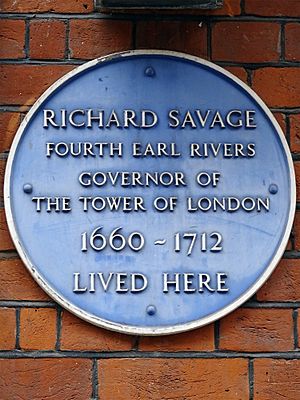Richard Savage, 4th Earl Rivers facts for kids
Quick facts for kids
General
The Right Honorable The Earl Rivers
|
|
|---|---|
| Personal details | |
| Born |
Richard Savage
ca. 1654 London, Middlesex, England |
| Died | 18 August 1712 (aged 57–58) Ealing Grove, Middlesex, London, England, Great Britain |
| Military service | |
| Allegiance | |
| Branch/service | English Army British Army |
| Years of service | 1686–1712 |
| Rank | General |
| Commands | Master-General of the Ordnance Constable of the Tower of London |
| Battles/wars | Williamite War in Ireland War of the Spanish Succession |
Richard Savage, 4th Earl Rivers (around 1654 – 18 August 1712) was an important English nobleman and soldier. He became a high-ranking officer in the English and later British Army.
Richard was the second son of Thomas Savage, the 3rd Earl Rivers. When his older brother Thomas died in 1680, Richard became known as Viscount Colchester. He used this title until his father passed away in 1694. At that point, Richard became the 4th Earl Rivers.
He held important positions such as Master-General of the Ordnance, which meant he was in charge of military supplies. He was also Constable of the Tower of London, overseeing the famous Tower. For a short time, he was even the commander of all forces in England before he died in 1712.
Contents
Early Life and Military Career
How Did Richard Savage Start His Career?
Richard Savage was part of the well-known Savage family. He was the second son of Thomas Savage, the 3rd Earl Rivers. Early in his life, Richard gained a reputation for being quite daring.
In 1681, after becoming Viscount Colchester, he joined the English Parliament. He represented the area of Wigan. Around the same time, in 1686, he also joined the Horseguards, a type of cavalry unit.
Joining William of Orange
Richard Savage was one of the first important people to support Prince William of Orange. This happened when William arrived in England in November 1688. Richard even went with William to London. Later, in 1689, Richard became a Member of Parliament for Liverpool.
Serving in Wars Abroad
Richard quickly rose through the ranks in the army. He fought bravely in the Williamite war in Ireland and in the Netherlands. He was promoted to Major-General in 1698 and Lieutenant-General in 1702.
In 1694, he became the 4th Earl Rivers after his father's death. This meant he could no longer be a Member of Parliament. Instead, he took his father's place in the House of Lords, which is part of the British Parliament.
In 1702, he served under Marlborough, a famous general. Marlborough thought highly of Richard's military skills. He even suggested Richard lead an invasion force against France in 1706.
Changes in Command and Politics
The invasion plan changed, and the expedition went to Portugal instead. Richard found himself replaced before much happened, so he returned to England. Marlborough then gave him a command in the cavalry.
Even though Marlborough supported him, Richard started to side with the Tories. This happened when it became clear that the Whig party was losing power. In 1710, he was made Constable of the Tower. This appointment, made without Marlborough's knowledge, showed the Whigs that their influence was ending.
Richard became very popular at court. In 1710, he was sent on an important mission to the Elector of Hanover. This was followed by his appointment in 1711 as Master-General of the Ordnance. This was a very important job, previously held by Marlborough himself.
In 1708, Richard Savage became one of the first members of the Privy Council of the United Kingdom. This happened after the Acts of Union 1707 created the Kingdom of Great Britain under Queen Anne.
Later Life and Family
What Was Richard Savage Like?
Jonathan Swift, a famous writer who knew Earl Rivers well, described him as a "knave." However, Swift might have been upset because Richard did not mention him in his will. Swift was critical of Richard's choices in his will.
In June 1712, Richard was promoted to the highest rank, General. He also became the commander-in-chief in England. He died just a few weeks later, on 18 August 1712.
Who Was His Family?
In 1679, Richard married Penelope, the daughter of Roger Downes. They had one daughter named Elizabeth, who later married the 4th Earl of Barrymore.
Richard also had other children. Since he had no legitimate son, the earldom passed to his cousin, John Savage, after his death. John Savage was a priest in the Roman Catholic Church. When John died around 1735, all the family titles came to an end.
See also


